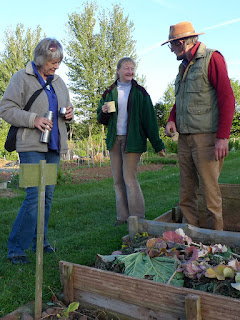Inspired by Compost
Kim (plot 20) is passionate about his compost, and he provided a really interesting and useful workshop about compost-making last week. First though, the kettle was boiled and luscious cheese scones (thank you, Yvonne!) and cakes were shared.
At the simplest level, composting consists of making a heap of wetted organic waste matter from your allotment or garden and waiting for the materials to break down into humus over a period of months. The resulting compost, spread onto the soil, provides essential nutrients to your growing plants, completing the cycle.
Kim explained how he produces the beautiful, crumbly and fertile compost which can be seen in the three bins on his plot beside the main path. The first stage is to chop all suitable green waste into small pieces and build up layers in the bin over time. Materials added include the manure delivered to the allotments; grass cuttings; kitchen waste including cardboard and eggshells; leaf mould (from a separate pile left to decay elsewhere); and ash. Kim separates out woody items and problem weeds such as dock roots and couch grass which might sprout again, puts them aside to dry, burns them, and uses the ash in the compost, so nothing is wasted.
Some people like to water their compost bin and cover it, and a good sprinkling of urine definitely helps, as does adding any (live) worms which have been uncovered whilst working on the allotment! The heap is left to heat up and break down into compost. The heat kills any weed seeds in the mixture. Kim turns the heap once, into the adjacent bin, which helps to mix the developing compost further. Over winter he will cover the heap in plastic to help retain the heat. The third bin contains older compost which is used on the beds or, as at present, as a courgette or squash hotbed. When that is finished the emptied bin will be used to start a new heap.
Personally, I left enthused and determined to tackle the huge pile of couch grass and woody weeds on my plot, and start proper composting.
At the simplest level, composting consists of making a heap of wetted organic waste matter from your allotment or garden and waiting for the materials to break down into humus over a period of months. The resulting compost, spread onto the soil, provides essential nutrients to your growing plants, completing the cycle.
Kim explained how he produces the beautiful, crumbly and fertile compost which can be seen in the three bins on his plot beside the main path. The first stage is to chop all suitable green waste into small pieces and build up layers in the bin over time. Materials added include the manure delivered to the allotments; grass cuttings; kitchen waste including cardboard and eggshells; leaf mould (from a separate pile left to decay elsewhere); and ash. Kim separates out woody items and problem weeds such as dock roots and couch grass which might sprout again, puts them aside to dry, burns them, and uses the ash in the compost, so nothing is wasted.
Some people like to water their compost bin and cover it, and a good sprinkling of urine definitely helps, as does adding any (live) worms which have been uncovered whilst working on the allotment! The heap is left to heat up and break down into compost. The heat kills any weed seeds in the mixture. Kim turns the heap once, into the adjacent bin, which helps to mix the developing compost further. Over winter he will cover the heap in plastic to help retain the heat. The third bin contains older compost which is used on the beds or, as at present, as a courgette or squash hotbed. When that is finished the emptied bin will be used to start a new heap.
Personally, I left enthused and determined to tackle the huge pile of couch grass and woody weeds on my plot, and start proper composting.
Submitted by Penny, plot 12A

Comments
Post a Comment